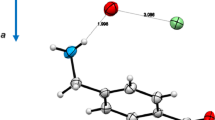Abstract
Benzotriazole, N,N′-dimethylpiperazine and N-methylpiperazine were applied to crystallize with 5-sulfosalicylic acid (5-H2SSA), affording three new binary molecular cocrystals [(C6H6N3 +)·(C7H5O6S−)]·H2O (1), [(C6H16N2 2+)1/2·(C7H5O6S−)]·H2O (2) and [(C5H14N2 2+)·(C7H5O6S−)2]·3H2O (3) under general conditions. Proton-transferring occurs from acid to nitrogen of N-donor compounds in all compounds 1, 2 and 3. Analysis of the hydrogen-bonding synthons and their effects on crystal packing were also presented in the context of crystal engineering and host-guest chemistry. In compound 1, 1-D infinite chains are extended to a 2-D layered architecture via strong O-H…O hydrogen bonds and then to a 3-D network by N-H…O interactions. Compou 2 and 3 both have the 1-D chain which is formed by O-H…O bonds and weak C-H…O hydrogen bonds. A common intramolecular S(6) [synthon I] ring is formed by the hydroxyl with the carboxyl group in all three compounds.
Similar content being viewed by others
References
Krishnamohan SCV. Cryatal engineering—where do we go from here? Cryst Growth Des, 2002, 2: 465–474
Braga D, Brammer L, Champness NR. New trends in crystal engineering. CrystEngComm, 2005, 7: 1–19
Bond AD, Jones W. Supramolecular Organization And Materials Design. Cambridge: Cambridge University Press, 2002
Du M, Zhang ZH, Guo W, Fu XJ. Multi-component hydrogen-bonding assembly of a pharmaceutical agent pamoic acid with piperazine or 4,4′-bipyridyl: A channel hydrated salt with multiple-helical motifs vs a bimolecular cocrystal. Cryst Growth Des, 2009, 9: 1655–1657
Fonari MS, Ganin EV, Vologzhanina AV, Antipin MY, Kravtsov VC. Persistent CH…π interactions in mefenamic acid complexes with cyclic and acyclic amines. Cryst Growth Des, 2010, 10: 3647–3656
Wang WH, Xi PH, Su XY, Lan JB, Mao ZH, You JS, Xie RG. Supramolecular assemblies of multifunctional diimidazole and dicarboxylic acids via various hydrogen bonds and X…π (X = π, CH) interactions. Cryst Growth Des, 2007, 7: 741–746
Endo K, Koike T, Sawaki T, Hayashida O, Masuda H, Aoyama Y. Catalysia by organic solids. Stereoselective diels-alder reactions promoted by microporous molecular crystals having an extensive hydrogen-bonded network. J Am Chem Soc, 1997, 119: 4117–4122
Du M, Zhang ZH, Zhao XJ, Cai H. Synthons competition/prediction in cocrystallization of flexible dicarboxylic acids with bent dipyridines. Cryst Growth Des, 2006, 6: 114–121
Zhang XL, Chen XM. Supramolecular architectures and helical water chains in cocrystals of melamine and aromatic carboxylic acids. Cryst Growth Des, 2005, 5: 617–622
Ranganathan A, Pedireddi VR, Rao CNR. Hydrothermal synthesis of organic channel structures: 1:1 hydrogen-bonded adducts of melamine with cyanuric and trithiocyanuric acids. J Am Chem Soc, 1999, 121: 1752–1753
Swift JA, Pivovar AM, Reynolds AM, Ward MD. Template-directed architectural isomerism of open molecular frameworks: Engineering of crystalline clathrates. J Am Chem Soc, 1998, 120: 5887–5894
Jetti RKR, Xue F, Mak TCW, Nangia A. 4-Tritylbenzoic acid. A molecules scaffold for wheel-and-axle host-guest inclusion compounds with a supramolecular axis. J Chem Soc Perkin Trans, 2000, 2: 1223–1232
Gautam GR. Supramolecular synthons in crystal engineering—a new organic synthesis. Angew Chem Int Ed, 1995, 34: 2311–2327
Duchamp DJ, Marsh RE. The crystal structure of trimesic acid (benzene-1,3,5-tricarboxylic acid). Acta Crystallogr Sect B, 1969, 25: 5–19
Paleos CM, Tsiourvas D. Thermotropic liquid crystals formed by intermolecular hydrogen bonding interactions. Angew Chem Int Ed, 1995, 34: 1696–1711
Smith G, Wermuth UD, Healy PC. Layered structures in proton-transfer compounds of 5-sulfosalicyclic acid with the aromatic polyamines 2,6-diaminopyridine and 1,4-phenylenediamine. Acta Crystallogr Sect C, 2005, 61: 555–558
Zhou CS, Ding LL, Cao MN, Meng XG. Three-dimensional networks in the 1:2 organic salts 2,2′-biimidazolium bis(3-carboxy-4-hydroxybenzenesulfonate) and 2,2′-bibenzimidazolium bis(3-carboxy-4-hydroxybenzenesulfonate) trihydrate. Acta Crystallogr Sect C, 2009, 65: 51–53
SAINT Software Reference Manual, Bruker AXS: Madison, WI, 1998
Sheldrick GM. SHELXTL NT Version 5.1. Program for solution and refinement of crystal structure. Germany: University of Gottingen, 1997
Author information
Authors and Affiliations
Corresponding author
Rights and permissions
About this article
Cite this article
Wang, L., Xu, L., Xue, R. et al. Cocrystallization of N-donor type compounds with 5-sulfosalicylic acid: The effect of hydrogen-bonding supramolecular architectures. Sci. China Chem. 55, 138–144 (2012). https://doi.org/10.1007/s11426-011-4394-8
Received:
Accepted:
Published:
Issue Date:
DOI: https://doi.org/10.1007/s11426-011-4394-8




